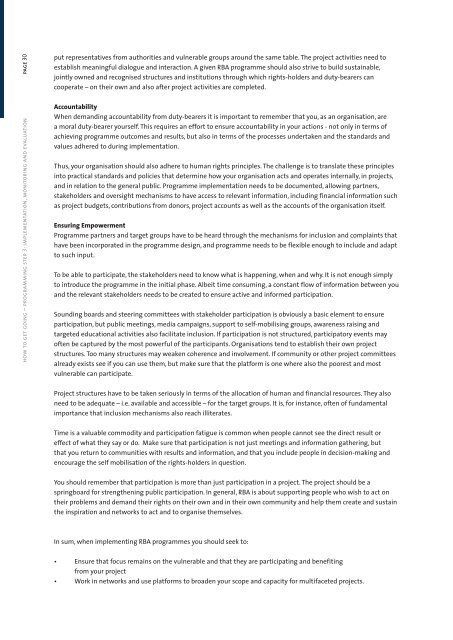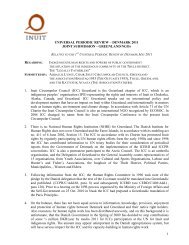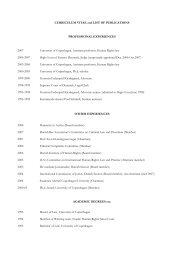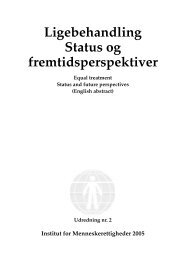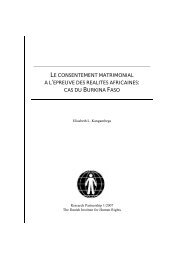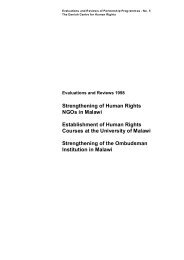applying a rights-based approach - Danish Institute for Human Rights
applying a rights-based approach - Danish Institute for Human Rights
applying a rights-based approach - Danish Institute for Human Rights
You also want an ePaper? Increase the reach of your titles
YUMPU automatically turns print PDFs into web optimized ePapers that Google loves.
how to get going – programming step 3: implementation, monitoring and evaluation page 30<br />
put representatives from authorities and vulnerable groups around the same table. The project activities need to<br />
establish meaningful dialogue and interaction. A given RBA programme should also strive to build sustainable,<br />
jointly owned and recognised structures and institutions through which <strong>rights</strong>-holders and duty-bearers can<br />
cooperate – on their own and also after project activities are completed.<br />
Accountability<br />
When demanding accountability from duty-bearers it is important to remember that you, as an organisation, are<br />
a moral duty-bearer yourself. This requires an ef<strong>for</strong>t to ensure accountability in your actions - not only in terms of<br />
achieving programme outcomes and results, but also in terms of the processes undertaken and the standards and<br />
values adhered to during implementation.<br />
Thus, your organisation should also adhere to human <strong>rights</strong> principles. The challenge is to translate these principles<br />
into practical standards and policies that determine how your organisation acts and operates internally, in projects,<br />
and in relation to the general public. Programme implementation needs to be documented, allowing partners,<br />
stakeholders and oversight mechanisms to have access to relevant in<strong>for</strong>mation, including financial in<strong>for</strong>mation such<br />
as project budgets, contributions from donors, project accounts as well as the accounts of the organisation itself.<br />
Ensuring Empowerment<br />
Programme partners and target groups have to be heard through the mechanisms <strong>for</strong> inclusion and complaints that<br />
have been incorporated in the programme design, and programme needs to be flexible enough to include and adapt<br />
to such input.<br />
To be able to participate, the stakeholders need to know what is happening, when and why. It is not enough simply<br />
to introduce the programme in the initial phase. Albeit time consuming, a constant flow of in<strong>for</strong>mation between you<br />
and the relevant stakeholders needs to be created to ensure active and in<strong>for</strong>med participation.<br />
Sounding boards and steering committees with stakeholder participation is obviously a basic element to ensure<br />
participation, but public meetings, media campaigns, support to self-mobilising groups, awareness raising and<br />
targeted educational activities also facilitate inclusion. If participation is not structured, participatory events may<br />
often be captured by the most powerful of the participants. Organisations tend to establish their own project<br />
structures. Too many structures may weaken coherence and involvement. If community or other project committees<br />
already exists see if you can use them, but make sure that the plat<strong>for</strong>m is one where also the poorest and most<br />
vulnerable can participate.<br />
Project structures have to be taken seriously in terms of the allocation of human and financial resources. They also<br />
need to be adequate – i.e. available and accessible – <strong>for</strong> the target groups. It is, <strong>for</strong> instance, often of fundamental<br />
importance that inclusion mechanisms also reach illiterates.<br />
Time is a valuable commodity and participation fatigue is common when people cannot see the direct result or<br />
effect of what they say or do. Make sure that participation is not just meetings and in<strong>for</strong>mation gathering, but<br />
that you return to communities with results and in<strong>for</strong>mation, and that you include people in decision-making and<br />
encourage the self mobilisation of the <strong>rights</strong>-holders in question.<br />
You should remember that participation is more than just participation in a project. The project should be a<br />
springboard <strong>for</strong> strengthening public participation. In general, RBA is about supporting people who wish to act on<br />
their problems and demand their <strong>rights</strong> on their own and in their own community and help them create and sustain<br />
the inspiration and networks to act and to organise themselves.<br />
In sum, when implementing RBA programmes you should seek to:<br />
• Ensure that focus remains on the vulnerable and that they are participating and benefiting<br />
from your project<br />
• Work in networks and use plat<strong>for</strong>ms to broaden your scope and capacity <strong>for</strong> multifaceted projects.


